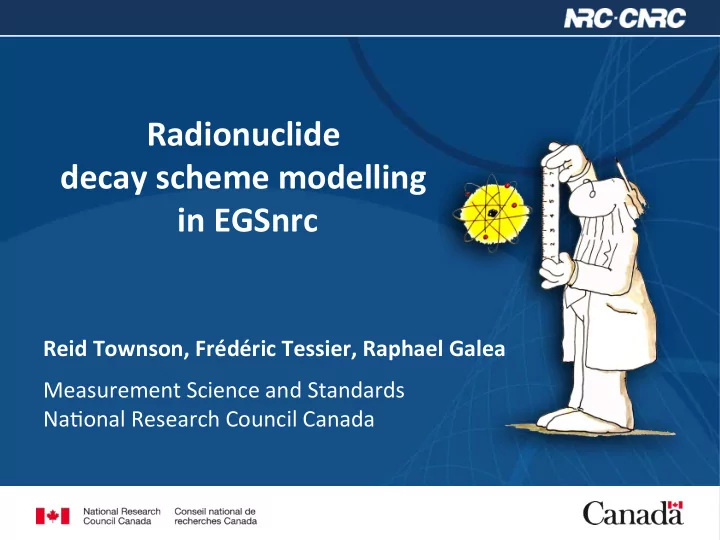

Radionuclide decay scheme modelling in EGSnrc Reid Townson, Frédéric Tessier, Raphael Galea Measurement Science and Standards Natonal Research Council Canada
Simulaton = geometry + source (+...)
An accurate partcle source is key Locaton Directon Energy ... and more?
Radionuclide decays are complex to model
Introducing: EGS_RadionuclideSource
Radionuclide data from LNHB Data from Laboratoire Natonal Henri Becquerel (LNHB) htp://www.nucleide.org/DDEP_WG/DDEPdata.htm ●
The ENSDF format is widely used Evaluated Nuclear Structure Data File (ENSDF) 67ZN 67GA EC DECAY (3.2613 D) ... 67ZN T Auger electrons and X ray energies and emission intensities: 67ZN T {U Energy (keV)} {U Intensity} {U Line} 67ZN T 67ZN T 8.61587 17.0 6 XKA2 67ZN T 8.63896 33.0 12 XKA1 ... 67ZN T 67ZN T 7.21-7.55 |] KLL AUGER 67ZN T 8.31-8.63 |] 60.4 21 KLX AUGER 67ZN T 9.39-9.65 |] KXY AUGER 67ZN T 0.732-0.997 167.5 21 L AUGER 67GA P 0.0 3/2- 3.2613 D 5 1000.8 12 67ZN N 1.0 1.0 1 1.0 67ZN L 0 5/2- STABLE 67ZN E 3.3 326.532 67ZN2 E CK=0.8836 15$CL=0.0989 12$CM=0.0164 4$CN=0.0011 1 67ZN L 93.31 1/2- 9.00 US 4 67ZN E 50.5 175.261 67ZN2 E CK=0.8834 15$CL=0.0991 12$CM=0.0164 4$CN=0.0011 1 67ZN G 93.307 1238.1 7E2 0.854 12 67ZN2 G KC=0.748 11$LC=0.0922 13$MC=0.01300 19$NC=0.000388 6 67ZN L 184.58 3/2- 1.028 NS 14 67ZN E 22.3 275.523 67ZN2 E CK=0.8832 15$CL=0.0993 12$CM=0.0164 4$CN=0.0011 1 67ZN G 91.263 153.09 7M1+E2 0.123 25 0.091 6
Radionuclide producton branches
Atomic relaxaton cascades Electron rearrangement fuorescent photons, Auger electrons, Coster-Kronig electrons ● Opton 1: Statstcal model using ENSDF data Opton 2: Sample inital vacancy (correlated with transiton) Simulate entre relaxaton cascade Uses EGSnrc relaxatons (EADL database)
Beta energies sampled from Fermi distributon
Coincidence count “realistcally” All partcles are assigned a tme of source emission No tme of fight modelling Currently no gamma-gamma directonal correlatons source->getTime()
Coincidence count “exactly” All emissions & secondaries resultng from the same disintegraton return the same “shower index” source->getShowerIndex()
The input fle is easy :start source: name = my_mixture library = egs_radionuclide_source activity = total activity of mixture, assumed constant ... optional arguments ... :start shape: definition of the source shape :stop shape: :start spectrum: Next slide... :stop spectrum: :stop source:
The input fle is easy :start source: ... (previous) ... :start spectrum: type = radionuclide nuclide = name of the nuclide (e.g. Sr-90) relative activity = [optional] the relative activity (sampling probability) for this nuclide in a mixture :stop spectrum: :start spectrum: type = radionuclide nuclide = next nuclide (e.g. Y-90) relative activity = ... :stop spectrum: :stop source:
Calibraton coefcients for the Vinten chamber
EGSnrc cumulates energy depositons EGSnrc reports energy deposited in nitrogen [eV]: Convert to total charge [C]: (average energy to create ion pair in nitrogen) The charge is deposited for exactly decays
Monte Carlo Experiment Accepted: Applied Radiation and Isotopes
Now we know where to focus In the experiment: Radio-impurites? ● Re-standardizaton by primary method? ● Sharpen uncertaintes by testng diferent conditons ● In the model: Pure water was used as the source soluton (even for gases!) ● Refnement of materials, geometries, source modelling etc. ●
Thanks to Patrick Saull for his help with beta spectra Thanks to LNHB for providing ENSDF data Reid Townson, Frédéric Tessier, Raphael Galea Measurement Science and Standards Natonal Research Council Canada
ENSDF records converted to c++ objects egs++ design is object-oriented
It's a tree-like structure
Simulatons provide experimental refnement An EGSnrc model of your detector allows you to: Validate experiments ● Predict detector response for unknown isotopes ● Refne experimental uncertainty budget ● Test geometrical variatons ● Test manufacturing tolerances ● Test radioimpurity efects ●
Calculatng calibraton factors: an example
Let's try this the “old way” 6 high intensity photon lines
Use a series of monoenergetc simulatons
Interpolate response k 1 =0.899 k 2 =0.917 k 3 =1.877 k 4 =2.146 k 5 =3.142 k 6 =4.140
Perform weighted sum using relatve intensites k 1 =0.899 P 1 =3.09 k 2 =0.917 P 2 =38.1 k 3 =1.877 P 3 =20.96 k hand = 1.533 k 4 =2.146 P 4 =2.37 k 5 =3.142 P 5 =16.6 k 6 =4.140 P 6 =4.59
Perform weighted sum using relatve intensites k 1 =0.899 P 1 =3.09 k 2 =0.917 P 2 =38.1 k 3 =1.877 P 3 =20.96 k hand = 1.533 -3.1% k 4 =2.146 P 4 =2.37 k exp = 1.583 k 5 =3.142 P 5 =16.6 k 6 =4.140 P 6 =4.59
The radionuclide source models a bit more
Closer agreement! k mc = 1.5547 -1.8% k exp = 1.583 (factor of 1.7 closer)
Simulatons provide answers With an accurate EGSnrc model at our disposal, we can now look at the questons: How does the uncertainty on a parameter afect ● measurement? What is the calibraton factor for a radionuclide not ● previously measured? What is the calibraton factor for a non-standard geometry? ● What is the efect of radioimpurites? ●
Simulatons can produce an absolute result
There was a problem with the detector model Initally, the modelled detector response was systematcally low An energy-dependent diference (~7%) ● This indicates a physical discrepancy: Material propertes (density, compositon)? ● Geometrical (wall thicknesses)? ●
We increased the gas pressure Varying within manufacturer tolerances could not account There was no tolerance on the nitrogen pressure (nominal 1MPa) Increasing the pressure ~7% worked (chi-squared optmized) ● Therefore, our model predicts a 7% higher pressure
Turns out it's corroborated Strikingly, a previous group also found a 7.2% higher pressure by simulatons of a similar chamber using PENELOPE
Afer a few minutes on the cluster...
Recommend
More recommend